A growing body of research indicates that today's youth are more engaged in global issues and more primed to make a difference. They are interested in how today’s problems are linked to the past and concerned about how they will affect the future. In this week’s column, we review some of the recently published books that introduce critical issues, contribute to conversation, invite further exploration, and support the activism of children and young adults.
Ages 4–8
The Bell Rang. James E. Ransome. 2019. Atheneum/Simon & Schuster.
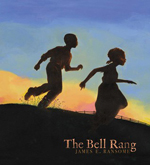 Monday. “The bell rings, / and no sun in the sky, / Daddy gathers wood. / Mama cooks. / We eat.” This is the start of the daily routine of enslavement on a plantation for the narrator, a young girl; her older brother, Ben; and her parents. Wednesday. Ben gives his sister a homemade doll before running to catch up with his friends, Joe and Little Sam. She loves on that doll all day long. Thursday. The three boys are gone. Her parents are beaten. Saturday. Joe and Little Sam are brought back to the plantation and beaten. But Ben is gone. Sunday. The slaves sing, hope, and pray that Ben made it to freedom. On Monday . . . With a simple free verse text and beautiful paintings, James E. Ransome tells a powerful story and leaves readers wondering what did happen on Monday.
Monday. “The bell rings, / and no sun in the sky, / Daddy gathers wood. / Mama cooks. / We eat.” This is the start of the daily routine of enslavement on a plantation for the narrator, a young girl; her older brother, Ben; and her parents. Wednesday. Ben gives his sister a homemade doll before running to catch up with his friends, Joe and Little Sam. She loves on that doll all day long. Thursday. The three boys are gone. Her parents are beaten. Saturday. Joe and Little Sam are brought back to the plantation and beaten. But Ben is gone. Sunday. The slaves sing, hope, and pray that Ben made it to freedom. On Monday . . . With a simple free verse text and beautiful paintings, James E. Ransome tells a powerful story and leaves readers wondering what did happen on Monday.
—SK
Carter Reads the Newspaper. Deborah Hopkinson. Ill. Don Tate. 2019. Peachtree.
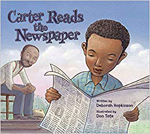 As a child, Carter read the newspaper to his illiterate father, a former slave who wanted to be an informed citizen, and later while working in a coal mine, he read to miners who couldn’t read. Determined to be educated, he eventually made it to Harvard, where it has been said a professor told him that Black people had no history. Carter (who earned a PhD in history) established Negro History Week in 1926 and devoted the rest of his life to informing people about Black history. Don Tate’s expressive mixed-media illustrations, which include portraits of past and contemporary Black leaders, complement this informative and engaging biography of Carter Woodson (1875–1950), who is recognized as the father of Black History Month. Back matter includes author and illustrator notes, a bibliography, timeline, list of Black leaders, and source notes.
As a child, Carter read the newspaper to his illiterate father, a former slave who wanted to be an informed citizen, and later while working in a coal mine, he read to miners who couldn’t read. Determined to be educated, he eventually made it to Harvard, where it has been said a professor told him that Black people had no history. Carter (who earned a PhD in history) established Negro History Week in 1926 and devoted the rest of his life to informing people about Black history. Don Tate’s expressive mixed-media illustrations, which include portraits of past and contemporary Black leaders, complement this informative and engaging biography of Carter Woodson (1875–1950), who is recognized as the father of Black History Month. Back matter includes author and illustrator notes, a bibliography, timeline, list of Black leaders, and source notes.
—SK
Crab Cake: Turning the Tide Together. Andrea Tsurumi. 2019. Houghton Mifflin.
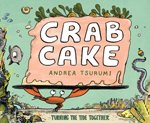 “Under the sea, where sunlight touches sand,” Clownfish, Manta Ray, Sea Turtle, Spiny Lobster, Octopus, and other ocean dwellers go about doing what they do. And crab bakes cakes. Then one night, with a big splash, a boatload of trash is dumped into the ocean. All the startled animals freeze, except for Crab. Crab bakes a cake, which brings everyone together. Nourished and encouraged, they come up with a clever plan, and with each animal contributing to the cleanup campaign (including Octopus, who inks a “Come Get Your Junk!” sign”), they restore their under-the-sea home and go on doing what they do. “Especially Crab.” Andrea Tsurumi’s full-page spreads of richly detailed cartoon illustrations add humor to this story with a gentle message about community and environmental action.
“Under the sea, where sunlight touches sand,” Clownfish, Manta Ray, Sea Turtle, Spiny Lobster, Octopus, and other ocean dwellers go about doing what they do. And crab bakes cakes. Then one night, with a big splash, a boatload of trash is dumped into the ocean. All the startled animals freeze, except for Crab. Crab bakes a cake, which brings everyone together. Nourished and encouraged, they come up with a clever plan, and with each animal contributing to the cleanup campaign (including Octopus, who inks a “Come Get Your Junk!” sign”), they restore their under-the-sea home and go on doing what they do. “Especially Crab.” Andrea Tsurumi’s full-page spreads of richly detailed cartoon illustrations add humor to this story with a gentle message about community and environmental action.
—CA
Meet Miss Fancy. Irene Latham. Ill. John Holyfield. 2019. Putnam/Penguin.
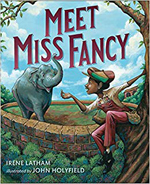 Frank adores everything about elephants but has never seen one in real life. When he hears that Miss Fancy, a circus elephant, is retiring to Birmingham’s Avondale Park, he sets off to meet her, only to be turned away at the park entrance by a “No Colored Allowed” sign. It’s 1913 and segregation prevails, but Frank doesn’t give up. He’s determined to meet Miss Fancy. The characters are fictional, but Miss Fancy was real and lived at Avondale Park for 21 years. John Holyfield’s lively illustrations give readers a glance into the world of Jim Crow laws that affected African Americans in the South through the experiences of one young boy. An author’s note about Miss Fancy and segregation laws provides a context for the engaging story.
Frank adores everything about elephants but has never seen one in real life. When he hears that Miss Fancy, a circus elephant, is retiring to Birmingham’s Avondale Park, he sets off to meet her, only to be turned away at the park entrance by a “No Colored Allowed” sign. It’s 1913 and segregation prevails, but Frank doesn’t give up. He’s determined to meet Miss Fancy. The characters are fictional, but Miss Fancy was real and lived at Avondale Park for 21 years. John Holyfield’s lively illustrations give readers a glance into the world of Jim Crow laws that affected African Americans in the South through the experiences of one young boy. An author’s note about Miss Fancy and segregation laws provides a context for the engaging story.
—SK
Ages 9–11
Mangoes, Mischief, and Tales of Friendship: Stories from India. Chitra Soundar. Ill. Uma Krishnaswamy. 2019. Candlewick.
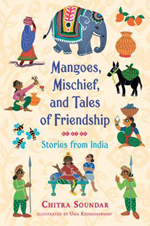 This collection of eight original tales with the flavor of traditional Indian folklore in both the telling and black-and-white artwork will delight children. Each story centers around the court of King Bheema, who hears subjects’ complaints and settles disputes with fairness. When the King is unable to preside, 10-year-old Prince Veera and his best friend, Suku, get permission to hold court. How do they handle the candy maker who charges a man for smelling the candy? How do they find a way to count all the crows in the kingdom? How do they convince the King that just because a man is poor doesn’t mean he brings bad luck? Each story is filled with humor and a bit of trickery. Readers will enjoy trying to solve the problems before the clever boys do.
This collection of eight original tales with the flavor of traditional Indian folklore in both the telling and black-and-white artwork will delight children. Each story centers around the court of King Bheema, who hears subjects’ complaints and settles disputes with fairness. When the King is unable to preside, 10-year-old Prince Veera and his best friend, Suku, get permission to hold court. How do they handle the candy maker who charges a man for smelling the candy? How do they find a way to count all the crows in the kingdom? How do they convince the King that just because a man is poor doesn’t mean he brings bad luck? Each story is filled with humor and a bit of trickery. Readers will enjoy trying to solve the problems before the clever boys do.
—SK
Superlative Birds. Leslie Bulion. Ill. Robert Meganck. 2019. Peachtree.
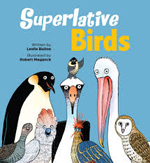 Leslie Bulion presents 20 clever poems about record-breaking birds from around the world. The first poem, “Superlative Birds,” establishes the theme and the last, “For the Birds,” is a call for action: “Let’s save our birds’ futures now.” Double-page spreads feature poems and science notes about 18 different “superlative birds” (including the smallest, the bee hummingbird found only in Cuba; the bird with the most feathers, the emperor penguin in Antarctica; and the smelliest, the hoatzin of the Amazon and Orinoco Basins) and Robert Meganck’s colorful digitally rendered cartoon illustrations. Throughout the book, a chatty chickadee contributes information about characteristics unique to birds and those they share with other animals. Back matter includes a glossary, notes about the poetry forms Bulion uses, and resources for further exploration about the world of birds.
Leslie Bulion presents 20 clever poems about record-breaking birds from around the world. The first poem, “Superlative Birds,” establishes the theme and the last, “For the Birds,” is a call for action: “Let’s save our birds’ futures now.” Double-page spreads feature poems and science notes about 18 different “superlative birds” (including the smallest, the bee hummingbird found only in Cuba; the bird with the most feathers, the emperor penguin in Antarctica; and the smelliest, the hoatzin of the Amazon and Orinoco Basins) and Robert Meganck’s colorful digitally rendered cartoon illustrations. Throughout the book, a chatty chickadee contributes information about characteristics unique to birds and those they share with other animals. Back matter includes a glossary, notes about the poetry forms Bulion uses, and resources for further exploration about the world of birds.
—CA
Ages 12–14
Biddy Mason Speaks Up (Fighting for Justice). Arisa White & Laura Atkins. Ill. Laura Freeman. 2019. Heyday.
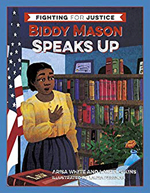 In a preface, the authors identify this book as a “creative act . . . of imagining Biddy Mason’s life” based on information available in the limited historical record that does not tell the history of everyone. A series of free verse poems (each with a colorful digital illustration) tells her life story of enslavement on a Mississippi plantation where she learned to be an herbalist and midwife, being sold and migrating West with a Mormon family, and finally finding freedom in California where she became a key figure in the first Black community of Los Angeles. The pairing of the biographical poems with pages of well-organized expository text (with definitions, photographs, text boxes, and timelines) and the inclusion of source notes, a bibliography, and an index make this an excellent classroom resource.
In a preface, the authors identify this book as a “creative act . . . of imagining Biddy Mason’s life” based on information available in the limited historical record that does not tell the history of everyone. A series of free verse poems (each with a colorful digital illustration) tells her life story of enslavement on a Mississippi plantation where she learned to be an herbalist and midwife, being sold and migrating West with a Mormon family, and finally finding freedom in California where she became a key figure in the first Black community of Los Angeles. The pairing of the biographical poems with pages of well-organized expository text (with definitions, photographs, text boxes, and timelines) and the inclusion of source notes, a bibliography, and an index make this an excellent classroom resource.
—CA
This Promise of Change: One Girl’s Story in the Fight for School Equality. Jo Ann Allen Boyce & Debby Levy. 2019. Bloomsbury.
 Jo Ann Allen was one of the African American students who walked into Clinton High School on August 27, 1956. “We are the first in Tennessee / or any Southern state / to cause an all-white public school / to change—to integrate. / . . . I can’t help feeling hopeful / (though hope can trip and fall) / to know that I am one of twelve / to break / this / racial / wall.” This memoir in verse (with insets of headlines and quotes from local, regional, and national newspapers; extracts of legislation and court rulings; and interviews) tells Jo Allen’s story in the fight for school equality. An epilogue and extensive back matter provide additional background and resources including a scrapbook of captioned photographs and a timeline of school desegregation and civil rights landmarks.
Jo Ann Allen was one of the African American students who walked into Clinton High School on August 27, 1956. “We are the first in Tennessee / or any Southern state / to cause an all-white public school / to change—to integrate. / . . . I can’t help feeling hopeful / (though hope can trip and fall) / to know that I am one of twelve / to break / this / racial / wall.” This memoir in verse (with insets of headlines and quotes from local, regional, and national newspapers; extracts of legislation and court rulings; and interviews) tells Jo Allen’s story in the fight for school equality. An epilogue and extensive back matter provide additional background and resources including a scrapbook of captioned photographs and a timeline of school desegregation and civil rights landmarks.
—CA
We Are Displaced: My Journey and Stories from Refugees Around the World. Malala Yousafzai. 2019. Little, Brown.
 In the first part of We Are Displaced, Malala Yousafzai tells the story of her family’s internal displacement from the Swat Valley in Pakistan in 2009, their exile to England after she was shot by Taliban soldiers in 2012, and her plan to continue activism for girls’ education. The second part includes oral histories of girls she has met in her world travels as an activist. Each entry is a personal story of flight from a homeland, loss, and survival as well as hopes and dreams for the future. Back matter includes a “How You Can Help” section, biographical notes on contributors, and photographs. In a time when, as Yousafzai points out in the prologue, “for any refugee or any person displaced by violence . . . it seems as if there is no safe place today,” this is thought-provoking reading for everyone.
In the first part of We Are Displaced, Malala Yousafzai tells the story of her family’s internal displacement from the Swat Valley in Pakistan in 2009, their exile to England after she was shot by Taliban soldiers in 2012, and her plan to continue activism for girls’ education. The second part includes oral histories of girls she has met in her world travels as an activist. Each entry is a personal story of flight from a homeland, loss, and survival as well as hopes and dreams for the future. Back matter includes a “How You Can Help” section, biographical notes on contributors, and photographs. In a time when, as Yousafzai points out in the prologue, “for any refugee or any person displaced by violence . . . it seems as if there is no safe place today,” this is thought-provoking reading for everyone.
—CA
Ages 15+
Fake News: Separating Truth from Fiction. Michael Miller. 2019. Lerner.
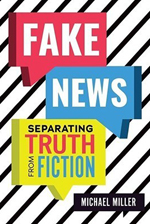 In the first chapter of Fake News, Miller points out that the term “fake news” is used in two ways: as “news items or social media post that are mostly or wholly untrue but are designed to look like real news stories” and as a means of labeling “legitimate new stories . . . in a negative light.” Subsequent chapters discuss topics such as the many forms of fake news, why fake news is harmful, how to tell real news from fake news, and how you can help fight fake news. This book on “separating truth from fiction” is reader-friendly. The well-organized text includes subtitles, numerous examples, captioned color photographs, and text boxes of related information; and the extensive back matter includes source notes, a glossary, a selected bibliography, further information (books, websites, films and videos), and an index.
In the first chapter of Fake News, Miller points out that the term “fake news” is used in two ways: as “news items or social media post that are mostly or wholly untrue but are designed to look like real news stories” and as a means of labeling “legitimate new stories . . . in a negative light.” Subsequent chapters discuss topics such as the many forms of fake news, why fake news is harmful, how to tell real news from fake news, and how you can help fight fake news. This book on “separating truth from fiction” is reader-friendly. The well-organized text includes subtitles, numerous examples, captioned color photographs, and text boxes of related information; and the extensive back matter includes source notes, a glossary, a selected bibliography, further information (books, websites, films and videos), and an index.
—CA
We Are Here to Stay: Voices of Undocumented Young Adults. Susan Kuklin. 2019. Candlewick.
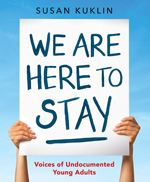 Listening to the voices of nine young adult undocumented immigrants who tell their stories through interviews with Susan Kuklin, readers can’t help but have empathy and respect for everything they endured to come to the United States to be with family, to get an education, and to escape violence and poverty in their countries of Colombia, Mexico, Ghana, Independent Samoa, and Korea. Kuklin had planned to include each young person’s photo in the book originally scheduled for publication in 2017, but because of uncertainty surrounding recent executive action on DACA recipients, she decided to withhold their identities to protect them, so the pages that would have held their portraits are blank. An extensive “Notes and Resources” section includes information on U.S. immigration laws, chapter notes, an author’s notes, resources, and an index. This is a timely book to read and, most importantly, to discuss.
Listening to the voices of nine young adult undocumented immigrants who tell their stories through interviews with Susan Kuklin, readers can’t help but have empathy and respect for everything they endured to come to the United States to be with family, to get an education, and to escape violence and poverty in their countries of Colombia, Mexico, Ghana, Independent Samoa, and Korea. Kuklin had planned to include each young person’s photo in the book originally scheduled for publication in 2017, but because of uncertainty surrounding recent executive action on DACA recipients, she decided to withhold their identities to protect them, so the pages that would have held their portraits are blank. An extensive “Notes and Resources” section includes information on U.S. immigration laws, chapter notes, an author’s notes, resources, and an index. This is a timely book to read and, most importantly, to discuss.
—SK
Susan Knell is a professor in the department of Teaching and Leadership at Pittsburg State University in Pittsburg, Kansas, where she teaches literacy and literature courses at the undergraduate and graduate level. Carolyn Angus is former director of the George G. Stone Center for Children's Books, Claremont Graduate University, in Claremont, California.
These reviews are submitted by members of the International Literacy Association's Children's Literature and Reading Special Interest Group (CL/R SIG) and are published weekly on Literacy Daily.